
The type of grass that’s found in pastures and isn’t corn, wheat, or other types of cereals is not the most nutritious of foods for humans, but for other animals, it is just the thing. Why is this? Because animals that eat grass have microorganisms in their gut that produce enough of an enzyme called cellulase, which breaks down cellulose in grass. Humans lack this enzyme, so grass just goes straight through the digestive system without contributing a thing. Yet grass is surprisingly rich in protein, carbohydrates, and minerals such as iron, phosphorus, magnesium, vitamin C, and vitamin E. Of course, it is abundant in fiber.
The animals listed here have systems that can break down grass and thus benefit from its nutrients. Some can eat mostly grass and remain healthy, while others sometimes need to supplement their diet with fruit, seeds, leaves, or bark. Continue reading to learn about 10 animals that eat grass.
#10 Grasshoppers
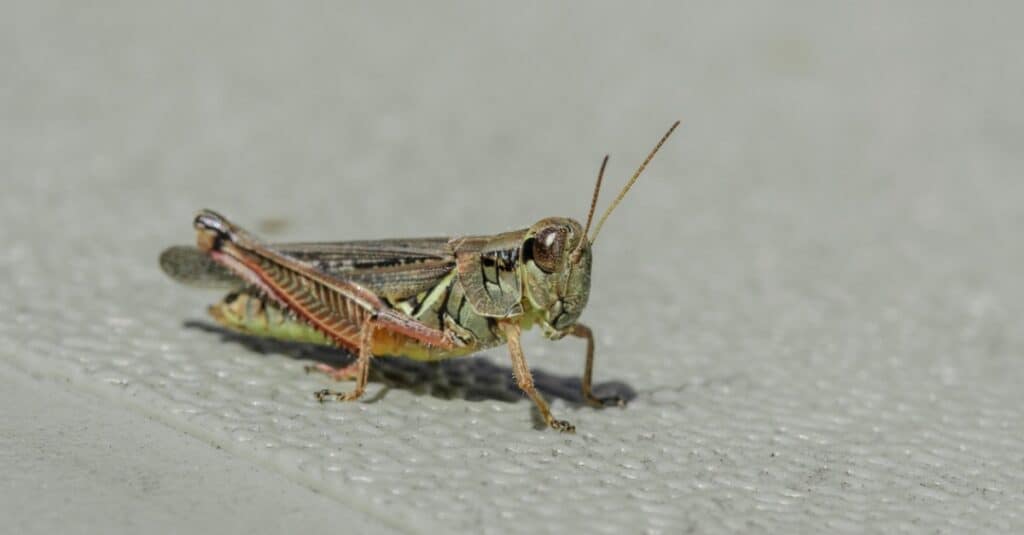
©iStock.com/Mainely Photos
Of course, these insects, with their famously powerful back legs, are partial to grasses, including quackgrass, junegrass, Johnsongrass, and even the Kentucky bluegrass of lawns. They are so partial to grass that swarms of them can devastate those types of grasses that humans eat such as corn, wheat, and oats. Some grasshoppers, such as the green-striped, like to nibble the edge of the blade about halfway up, chew through the leaf, hold on to the bit that’s been cut off, and use their feet to deliver it to their mandibles. Other grasshoppers will chew the grass down to the crown.
Tilling the soil can inhibit their activity and prevent them from inflicting significant damage on your garden. The best times of the year are mid-fall and early spring in order to ensure eggs are laid during summer and those meant to hatch soon are both affected. Because they prefer areas with dense growth encouraging the presence of birds can also serve as a deterrent to them.
#9 Geometric Tortoise
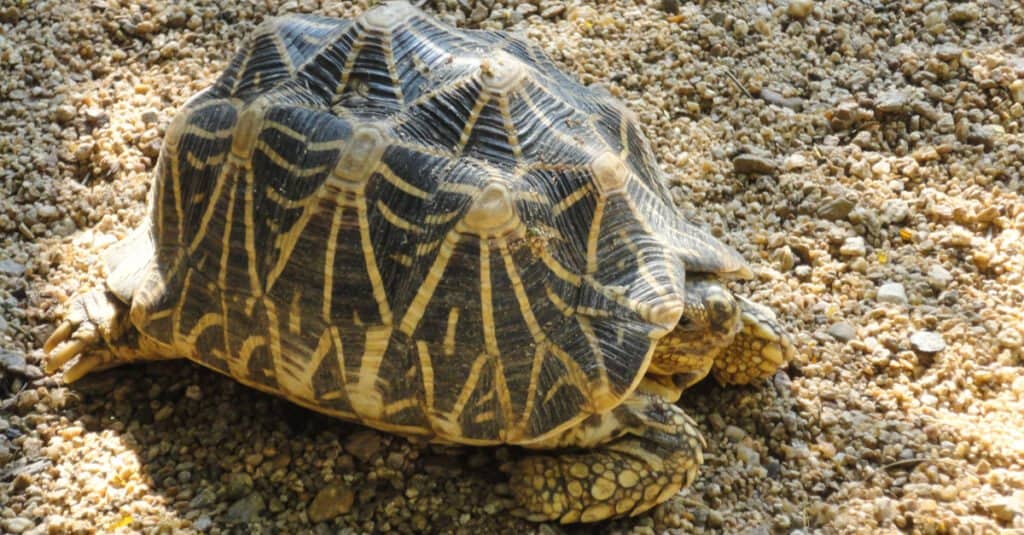
©Lost Pirate/Shutterstock.com
This tortoise, endemic to South Africa’s Cape Province, is a grass specialist. Indeed, the starry pattern of its domed shell probably evolved to camouflage it as it moves through the grasses it eats for food. Found in a shrubby habitat called the renosterveld, this tortoise likes to restrict itself to such grasses as red oat grass, Bermuda grass, Briza maxima, and Pentaschistis curvifolia which is also native to the Cape Province. The tortoise eats by grabbing the plant with its mouth and simply ripping it out of the ground, so it avoids tough plants that are hard to dig up.
#8 Grass Skipper Caterpillars

Skipper caterpillars prefer simple grasses to more exotic plants.
©colin robert varndell/Shutterstock.com
While other moths and butterfly caterpillars chow down on such fancy plants as viburnum, milkweed, blueberry, blackberry, sassafras, witch hazel, and wild and domesticated crucifers, the caterpillars of these plain little butterflies with their clubbed antennae eat grasses. The caterpillars themselves are not showy, with prominent heads and simple green or brown bodies. They graze upon bluegrass, rice cutgrass, bent grass, timothy, orchard grass, love grass, and purple top.
#7 Canada Goose
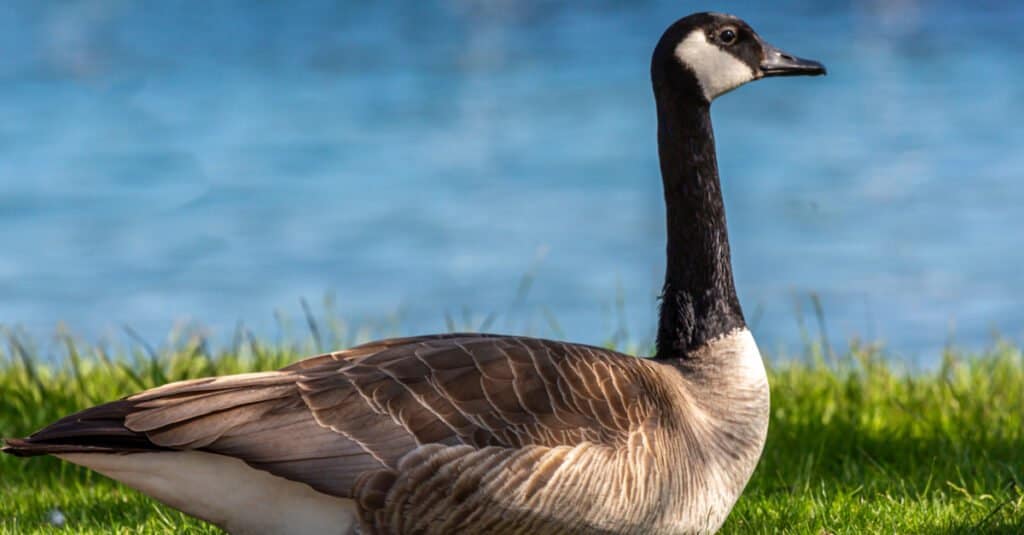
©David McIntosh/Shutterstock.com
This large goose, familiar to most people through its brown body and its black neck and head with the white cheek patches that meet under the throat, is native to North America. They don’t restrict themselves to grasses but do graze, especially during the warmer months. Like the geometric tortoise, they grab the blade of grass in their beak and pull it up. That way they eat not just the blades and stems but the roots. When the grass produces seeds, the geese eat that as well.
#6 Mites
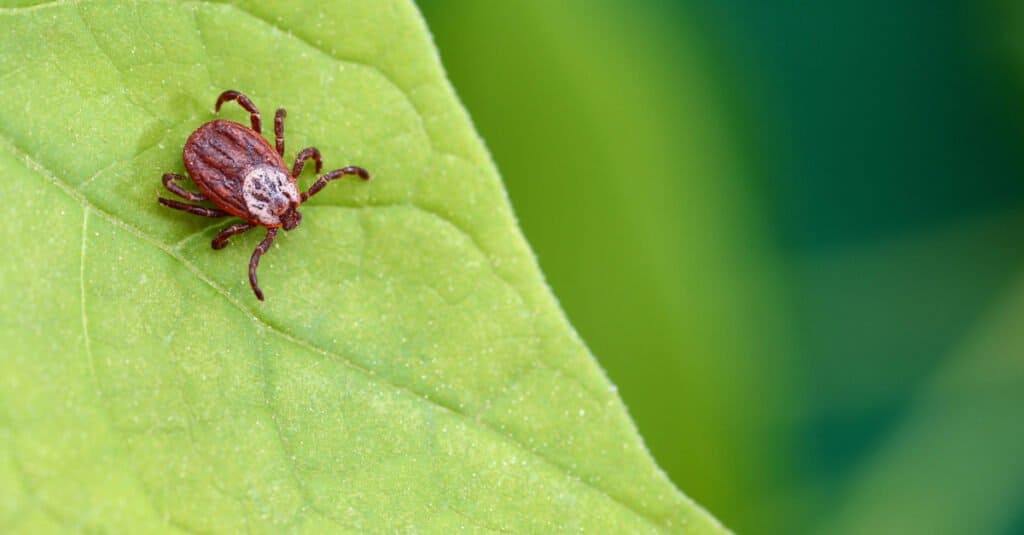
©Spok83/Shutterstock.com
Mites are invertebrates, but they are not insects. They are relatives of spiders, have eight legs, and even spin webs. The presence of these webs may be the first sign that a lawn has a mite problem. The mites themselves are so tiny that a person needs a magnifying glass to see them. What makes them even harder to see is that they feed on the underside of the grass blade. They are especially troublesome during a drought, but it’s unusual to have such an infestation that a large portion of the lawn is damaged.
#5 Western Gray Kangaroo

©iStock.com/Lea Scaddan
One of the largest and most common of Australia’s many marsupials, the western gray kangaroo grazes at night in groups of two to 15 in the woods, shrubs, and savannas of southern Australia. The reason the kangaroo can get nutrition from the grasses it eats is because its cecum, a little pouch in the large intestine that’s attached to the last part of the small intestine, has microbes that help break down cellulose. Because of the fiber, the animal gets from grasses as well as leaves and tree bark, it needs little water.
#4. Volcano Rabbit

©Arlette Cruz/Shutterstock.com
This little grayish-brown rabbit, which grows from about 9 to 12 inches long and weighs between 13 and 12 ounces, gets its name because it lives in the forests in the volcanic region that surrounds Mexico City. It specializes in zacaton or bunch grasses such as Festuca amplissima as well as species of spiny grass. It will also eat tree bark and tender herbs.
#3 Giant Panda
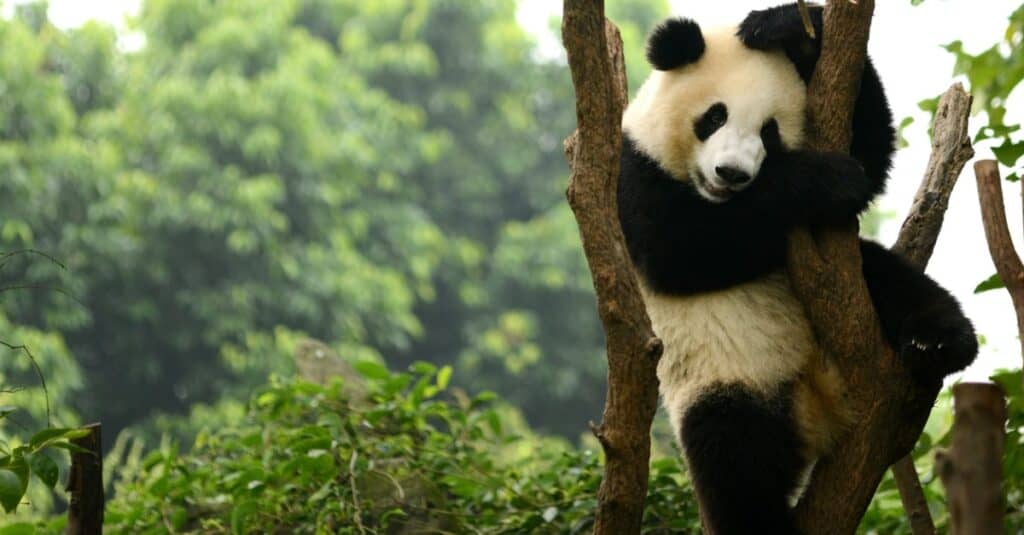
©iStock.com/dangdumrong
This bear, which is native to China, is famous for its black and white coloration, its black pompom-shaped ears, and all-around cuteness. The panda eats almost nothing but bamboo, a giant grass. What makes this odd is that the panda is a carnivore and has a carnivore’s digestive system, which means it has one stomach and a short intestinal tract. Still, bamboo is abundant where the panda lives, so the panda eats it, every day for at least ten hours a day. It has even evolved a false thumb to hold on to the bamboo stalks and strip off the leaves.
#2 White Rhinoceros
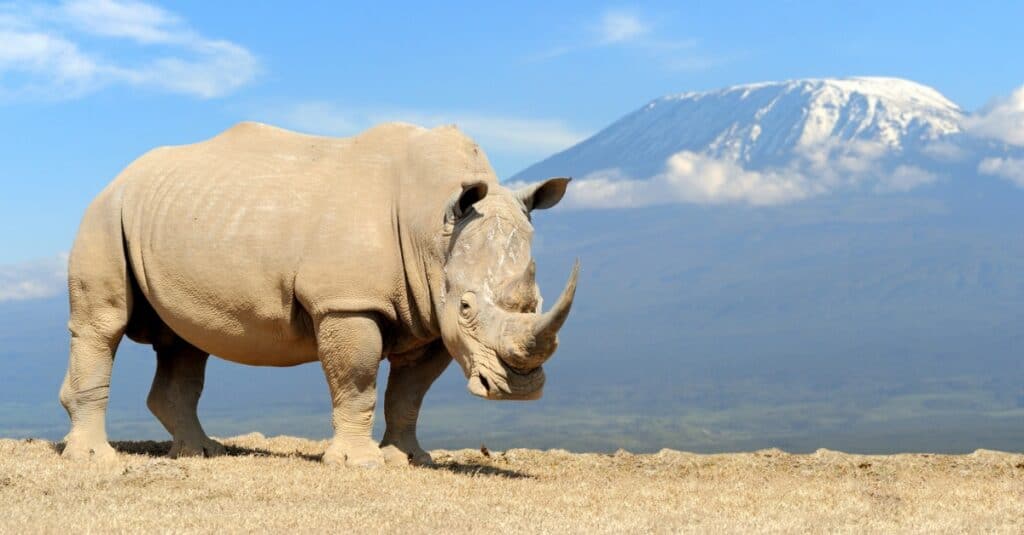
©iStock.com/Byrdyak
This massive African mammal has a mouth that evolved to graze. This probably lead to its name, which was mistranslated from the Dutch “wijd” to “white.” “Wijd” means “wide” and describes the animal’s upper lip. As for its hide, it is uniformly gray.
There are two subspecies of white rhinos, the southern and the northern, and both of these animals eat grass. The southern is near threatened, and the northern is critically endangered and may even be extinct in the wild. Both like to graze panic grasses, finger grass, and signal grass, which are easy for the animals to pluck with their wide lips and toughened lip pads. The cellulose of the plant then passes to the animal’s stomach, where it is broken down in a back chamber by microorganisms, much like it’s broken down in the cecum of the western gray kangaroo.
#1 Cattle and Other Ruminants
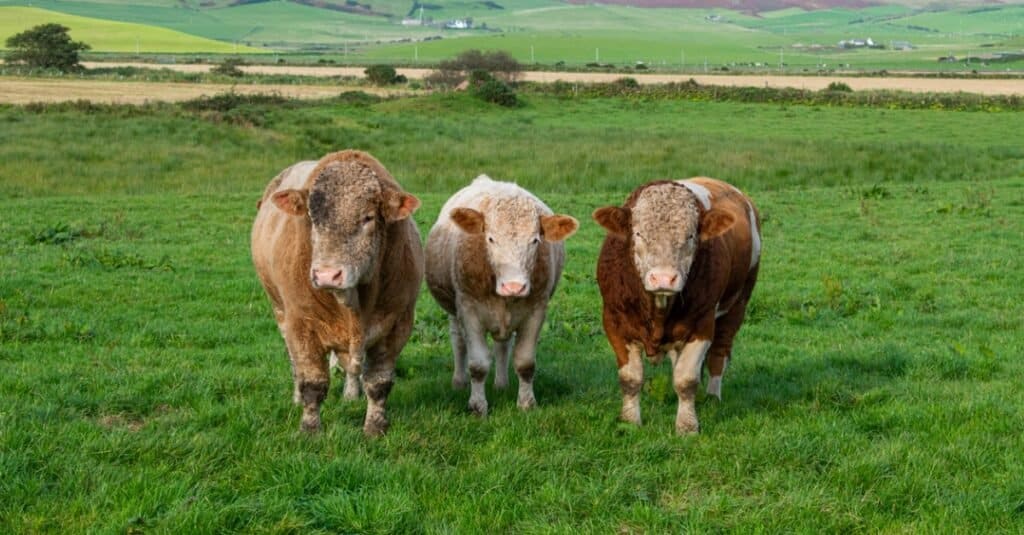
©iStock.com/Rodrigo Narvaez
Ruminants are animals such as wild and domestic cattle, sheep, deer, antelopes, giraffes, and goats that are champions when it comes to the eating and digestion of grasses and other plant material. Cattle and sheep have the most sophisticated digestive systems when it comes to digesting grass. Though they are said to have four stomachs, they have one stomach with four compartments. These are the rumen, reticulum, omasum, and abomasum. The digestive systems of deer are much simpler, so they tend to eat grasses when they’re young and tender.
When an animal such as a cow or sheep eats grass, the grass goes first to the rumen and the reticulum. There it is fermented and the cellulose is broken down thanks to the action of microorganisms. The animal then brings up the solids, which come in the form of a cud, which they chew. Chewing breaks it down even further. Then, the twice-chewed food and the liquid that was left in the rumen and reticulum are passed into the omasum, which controls how it enters the abomasum. The abomasum acts the same way as the single stomach found in humans and other mammals and further breaks down foods through acids and enzymes such as cellulase. After that, everything passes down to the intestines.
Summary of 10 Animals That Eat Grass
| Number | Animal |
|---|---|
| #1 | Cattle and Other Ruminants |
| #2 | White Rhinoceros |
| #3 | Giant Panda |
| #4 | Volcano Rabbit |
| #5 | Western Gray Kangaroo |
| #6 | Mites |
| #7 | Canada Goose |
| #8 | Grass Skipper Caterpillars |
| #9 | Geometric Tortoise |
| #10 | Grasshoppers |
The photo featured at the top of this post is © JWPhotoworks/Shutterstock.com
Thank you for reading! Have some feedback for us? Contact the AZ Animals editorial team.






